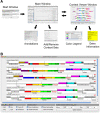JContextExplorer: a tree-based approach to facilitate cross-species genomic context comparison
- PMID: 23324080
- PMCID: PMC3560190
- DOI: 10.1186/1471-2105-14-18
JContextExplorer: a tree-based approach to facilitate cross-species genomic context comparison
Abstract
Background: Cross-species comparisons of gene neighborhoods (also called genomic contexts) in microbes may provide insight into determining functionally related or co-regulated sets of genes, suggest annotations of previously un-annotated genes, and help to identify horizontal gene transfer events across microbial species. Existing tools to investigate genomic contexts, however, lack features for dynamically comparing and exploring genomic regions from multiple species. As DNA sequencing technologies improve and the number of whole sequenced microbial genomes increases, a user-friendly genome context comparison platform designed for use by a broad range of users promises to satisfy a growing need in the biological community.
Results: Here we present JContextExplorer: a tool that organizes genomic contexts into branching diagrams. We implement several alternative context-comparison and tree rendering algorithms, and allow for easy transitioning between different clustering algorithms. To facilitate genomic context analysis, our tool implements GUI features, such as text search filtering, point-and-click interrogation of individual contexts, and genomic visualization via a multi-genome browser. We demonstrate a use case of our tool by attempting to resolve annotation ambiguities between two highly homologous yet functionally distinct genes in a set of 22 alpha and gamma proteobacteria.
Conclusions: JContextExplorer should enable a broad range of users to analyze and explore genomic contexts. The program has been tested on Windows, Mac, and Linux operating systems, and is implemented both as an executable JAR file and java WebStart. Program executables, source code, and documentation is available at http://www.bme.ucdavis.edu/facciotti/resources_data/software/.
Figures



References
Publication types
MeSH terms
LinkOut - more resources
Full Text Sources
Other Literature Sources
Research Materials

